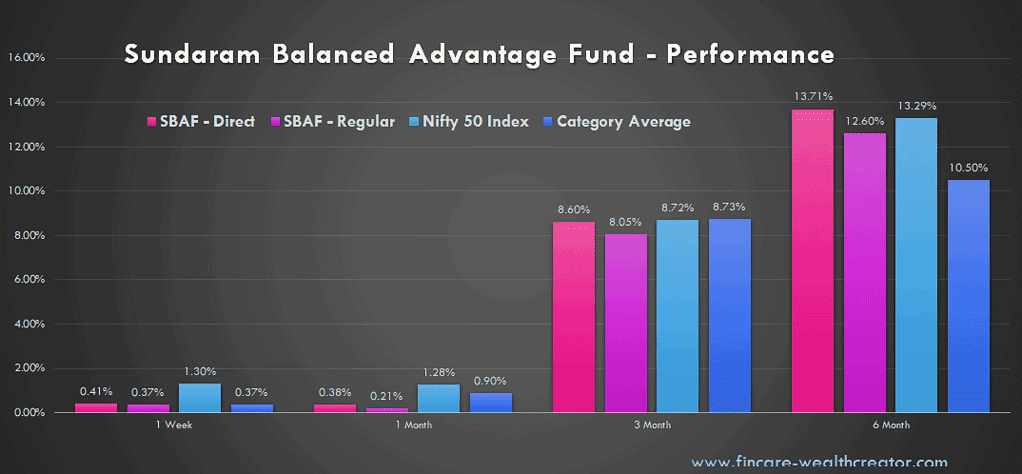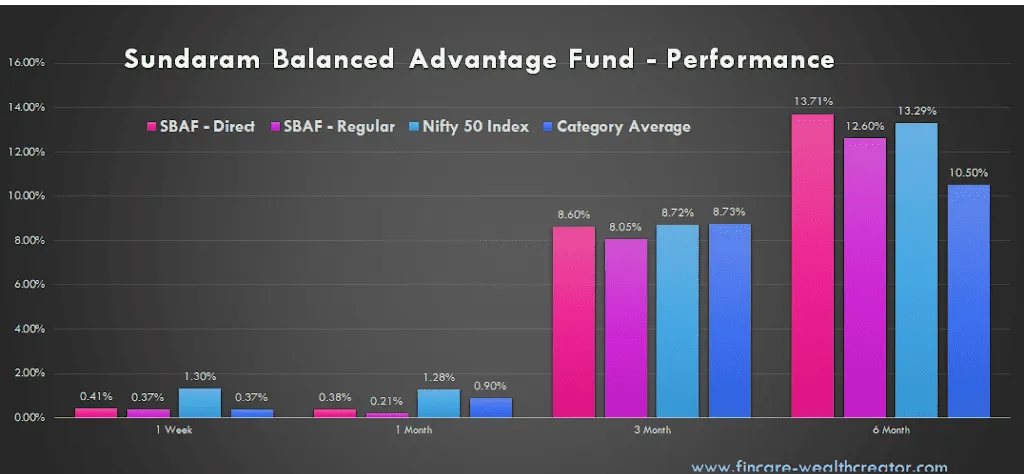Table of Contents
ToggleSundaram Balanced Advantage Fund is a hybrid mutual fund that came as NFO on 5th March 2020. It is managed by the Sundaram mutual fund Asset Management Company.
This article is a review of a 6 months old fund that is performing at a rate of 15.23% from the time of inception. The fund is currently holding a size of 628 Cr.
Since the fund was launched during the time of the COVID-19 crash in India, this fund could show a fantastic figure when compared to other actively managed mutual funds.
Anyhow, the fund the direct option has performed over the market index (Nifty 50) in the last 6 months of performance.
Hybrid Fund:
There are many types of equity mutual funds available in India. In which hybrid mutual funds are actively managed with a combination of asset classes.
Hybrid funds are invested in a certain percentage of equity shares, bonds, and other fixed-income materials.
These funds are chosen by investors to minimize market risk. Hybrid funds are highly diversified as they hold both equity and debt in the majority.
Hybrid funds are seven types,
1. Conservative Hybrid Fund – 10% – 25% in equity, 75% – 90% in debt.
2. Balanced Hybrid Fund – 40% – 60% in equity, 60%-40% in debt.
3. Aggressive Hybrid Fund – 65%-80% in equity, 35%-20% in debt.
4. Balanced Advantage Fund – Equity or debt is managed dynamically.
5. Multi Asset Allocation – Investments in three allocations of a minimum of 10% each.
6. Arbitrage Fund – Minimum 65% of investment in Equity.
7. Equity Savings – Minimum 65% in Equity and Minimum 10% in Debt.
Sundaram Balanced Advantage Fund:
The fund comes into a balanced advantage hybrid class. So, the fund can be managed dynamically by the fund manager on asset allocation.
A balanced advantage fund unlike other hybrid funds provides better performance. So, the risk involved is slightly higher.
Sundaram Balanced Advantage Fund has an asset allocation of
- Equity – 69.89%
- Large Cap – 55.49%
- Mid Cap – 10%
- Small Cap – 0.46%
- Debt – 16.39%
- NCD & Bonds – 14.68%
- GOI – 1.17%
- Others (Fixed Income Material) – 13.72%.
The fund is compared with Nifty 50 as a benchmark index.
The expense ratio of the fund is,
- Regular – 2.38%
- Direct – 0.54
This fund can be started with a minimum of Rs. 100 every month as a systematic investment plan.
The fund has been categorized as moderate-high risk.
Sundaram Balanced Advantage Fund (SBAF) – Performance
In terms of performance, the comparison is made between SBAF Direct, SBAF regular, Nifty 50 Index, and Category average.

From the above image, you can clearly understand that the SBAF Direct option has performed ahead of its competitors only in 6 months’ performance.
In a recent time frame, like less than a 3-month analysis, both direct and regular funds have stabbed under the category average and Nifty 50 index.
In all the categories, the Nifty 50 index has shown a better or equal performance.
So, it is better to invest in index funds i.e. Nifty 50 index funds. For a long time, it has been hard to beat the index with hybrid funds. Of course, hybrid funds have their characteristics.
Risk Analysis:
· Since the fund is less than one year, the risk analysis is not applicable. Should wait for another 5 months to have a detailed analysis of risk management.
· As of day, the fund has to show better risk-adjusted returns with average volatility.
Insights to Investors – Sundaram Balanced Advantage Fund:
· Sundaram balanced advantage fund can be an option in your goal-based investment.
· There are a few balanced advantage funds that have obtained a 10% return per annum when holding for more than 10 years.
· So, have a session with your financial advisor and have clear planning towards your goal.
· In the long run, this fund will not beat the Nifty 50 Index. Might be it can perform ahead of its category average.
· Instead of a hybrid fund, you can have index funds and short term debt funds.
